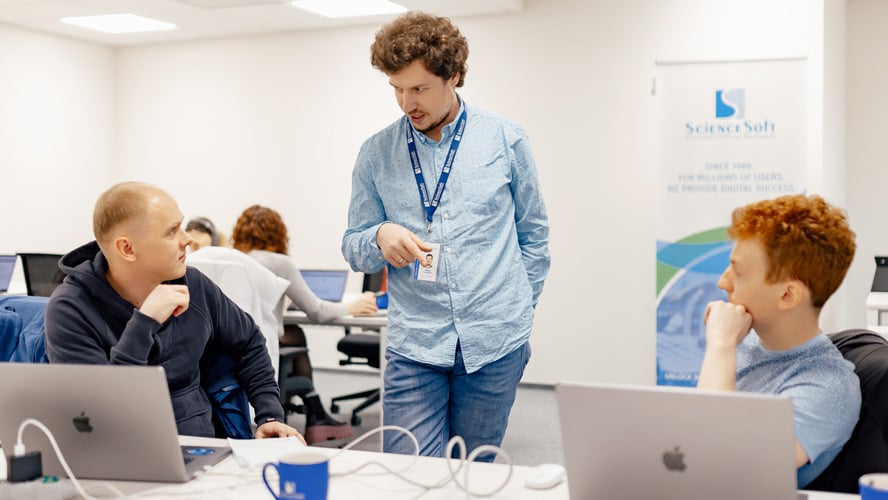Mobile App Development Services
A Blend of High-Standard Mobile Programming and Creativity
In mobile development since 2005, ScienceSoft creates native, cross-platform and progressive web applications with stable performance, human-centered design and a unique selling proposition to stand out in a fierce market.
Our Mobile Application Development Services
ScienceSoft assists in specific development stages as well as provides full-cycle mobile app implementation. Our mobile app development services include:
We analyze the market and your brand identity to spot and manifest your competitive advantage.
We assist with app concept finalization, advise on platform/device compatibility, plan project activities, and optimize development costs.
ScienceSoft is ready to complement your mobile app with a web app, web portal, online store or SaaS.
Well-versed in a wide range of APIs, we guarantee seamless integration with back ends and any third-party software.
Our ISTQB-certified test engineers perform functional, performance, security, UX, and accessibility testing.
ScienceSoft offers post-launch L1–L3 support, compliance, security, and performance management & app evolution.
Our developers redesign the architecture, refactor code, and offer new look and feel to legacy mobile apps.
Mobile App Development Approaches We Use
Mobile app development services are aimed at building iOS & Android applications that effectively complement or substitute web solutions. ScienceSoft ensures app success by delivering striking UI, secure app code, and resilient back ends. We provide professional development of the following app types:
Apps for iOS and Android
Near-native mobile apps
Techs: React Native, Flutter, Xamarin
Apps built from a single codebase for both iOS and Android but treated by the mobile OS as if they were native.
Hybrid mobile apps
Techs: Cordova, Ionic
Apps developed using web technologies (HTML, CSS, JavaScript) and displayed via WebView, an “invisible browser” system component that exists in both Android and iOS.
In-browser web apps designed with a single codebase that adapts to different screen sizes (desktop, tablet, mobile) using responsive design techniques.
Enhanced responsive web apps that offer native-like features (offline access, push notifications, home screen installability).
*PWAs (Progressive Web Apps) are responsive apps that can be accessed on mobile via a shortcut. PWAs help increase engagement by 90%+, cut load time by 2.5x, and make desktop & mobile conversions even. Learn more about PWAs.
Apps for other ecosystems
Smartwatch apps
Apps for watchOS, Wear OS, and other smartwatch platforms. Often, they serve as companions to full-scale apps on smartphones, providing notifications, fitness tracking, and quick interactions.
Smart TV apps
Apps for Apple TV (tvOS), Android TV, Roku, Fire TV, and similar platforms. Though not strictly mobile, they often share code with mobile apps (e.g., for streaming apps such as Netflix and YouTube).
Apps for smart glasses and AR/VR wearables
Apps for AR/VR headsets like Meta Quest, Apple Vision Pro, Google Glass Enterprise, Microsoft HoloLens. Often paired with mobile apps for setup and control.
IoT apps
Apps that serve as interfaces for IoT ecosystems (e.g., Apple Home, Google Home, Ring, Tesla app, BMW Connected). The mobile app is the control hub, while services run on distributed devices or in the cloud.
App Types We Develop: Industry & Use Cases
Building All Mobile Features Modern Users Need
Whether creating an enterprise or consumer mobile app, we rely on our expertise in different techs and tools to make an app truly helpful and worth taking your users’ screen space. Though we can repeat the features, no two apps are identical: we find a unique value proposition for each app and tailor the functionality uniquely to its audience’s needs.
Geolocation management
Messaging and voice/video calling
Multi-device synchronization
Immersive experience
QR code scanning
Push notifications
Integration with wearables and smart TV
Benefit from a Smoothly Organized Project Flow
We understand that besides our tech expertise, you want to assess how comfortable it will be to work with us. We’ve described all the key sides of our cooperation so that you know what to expect.
Project scoping
Read about our techniques for analyzing a client’s requirements, scoping the project accurately, and avoiding scope creep.
Collaboration
Check different forms of collaboration we employ to keep a client informed of the project’s progress and arising challenges.
Risk management
Find out the groups of risks we take into account and our approach to effective risk mitigation.
Project documentation
See a comprehensive scope of documents we prepare at each stage of a software development life cycle (+ real-life examples).
Knowledge management
Learn how we incorporate knowledge management into all our processes. Check the examples of knowledge assets we typically create.
Reporting
Check the reporting tools we use and view types and examples of reports we routinely provide to clients.
Post-launch warranty
Get to know what our post-launch warranty covers and why you can be confident of having no severe issues with the delivered software.
Change request management
Learn how we organized the process of recording, assessing, prioritizing, and implementing feasible change requests to prevent scope creep.
Cost of Mobile App Development
The development cost of a mobile app of average complexity varies between $80,000 and $200,000. Please note that we are talking about average figures. Surely, there are apps that cost less or more — it all depends on your requirements. To calculate the cost accurately, we need to factor in:
- App functionality.
- Technologies used in the app (standard programming languages and frameworks or techs to build advanced capabilities like image processing, voice recognition, etc.).
- Visual design and level of interactivity.
- Integrations with third-party services and systems.
- Platforms to target (iOS, Android, or both) and a chosen development approach (native or cross-platform).
- The availability of a corresponding web app.
Want to Understand the Cost of Your Mobile App Project?
Just answer a few simple questions about your needs. This will help our experts better understand your challenge and provide a tailored estimate much quicker.
Thank you for your request!
We will analyze your case and get back to you within a business day to share a ballpark estimate.
In the meantime, would you like to learn more about ScienceSoft?
- Project success no matter what: learn how we make good on our mission.
- 4,200+ successful projects: explore our portfolio.
- 1,400+ incredible clients: read what they say.

In terms of costs, we can roughly group mobile apps by the complexity of functionality and design and the development efforts required.
|
|
Simple app |
App of medium complexity |
App of high complexity |
|---|---|---|---|
|
Features
|
|
|
|
|
Cost of a mobile app for business needs
|
$30,000–$80,000
|
$80,000–$200,000
|
$200,000–$500,000
|
|
Cost of a mobile product for commercial distribution
|
$80,000–$150,000 |
$150,000–$300,000 |
$300,000+ |
Our Full Technology Stack for Mobile Projects
Advanced Technologies We’re Skilled In
Click on the technologies marked with an arrow to learn more about ScienceSoft’s related expertise.
Move Your Mobile Project On at Your Convenient Pace
Just know that with ScienceSoft, you can move as fast as that:
- Up to 1 hour to get an initial response to your request and know a sales manager assigned to your company.
- 2–4 days to get CVs of mobile developers with the required skills and choose the best time for interviews.
- 1–2 weeks to assemble a full project team and set off.
- 2–3 months to get an MVP ready and launched.
- 3–10 months to get a full-fledged mobile app.
- Lifetime to evolve your app following volatile market trends and user needs.
ScienceSoft Answers Frequent Questions
I run a startup and need to launch a mobile app. What cost range can I expect?
We can precisely estimate the project cost only after a thorough research of the app's specific functional scope as well as the techs chosen for its implementation. But if you need rough estimates, the price range for a native app of medium complexity is from $30,000 to $70,000.
What is an average duration of a mobile project? Are there any ways to speed up the development if I need to launch an app asap?
Depending on the scope and tech stack, mobile app development can take from 3 to 10 months (+ 2–4 months for a complementing web app). To reduce time-to-market, ScienceSoft prioritizes features, focusing on the core ones first. We roll out an MVP app in just 2–3 months and continue enhancing it iteratively.
How can I track the progress of my project if I outsource it to ScienceSoft?
ScienceSoft has a mature system of KPIs (budget required vs. budget remaining, cycle time, team’s proactivity, etc.) that we use in managing our mobile app projects. At the start of cooperation, we give you access to our internal progress-tracking tools (Jira, Confluence) and discuss how often we will report on the project progress.
Do you help organize a smooth transfer of an app development project from a different vendor?
Yes, we can set up knowledge transfer sessions and request app documentation from your previous vendor. If the vendor’s input is insufficient, we can audit the app first to understand its current state and plan further development.
Do you work with security-sensitive apps?
Yes, our team has vast experience in developing healthcare and BFSI apps that process highly sensitive data. We follow OWASP Mobile Application Security methodology to ensure reliable access and data protection in our apps.





















